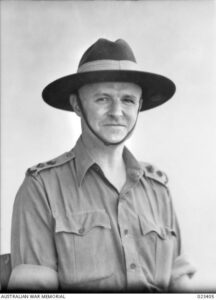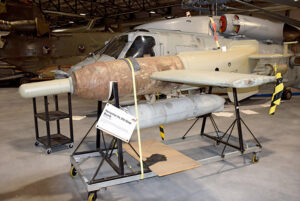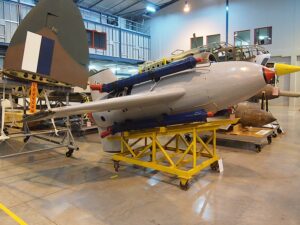- Author
- A.N. Other
- Subjects
- History - general, Aviation
- Tags
-
- RAN Ships
- None noted.
- Publication
- December 2023 edition of the Naval Historical Review (all rights reserved)
The following report has been compiled by Mark Meredith, one of our members, following a recent visit to the Treloar Centre.
The Australian War Memorial (AWM) has a conservation and storage facility comprising three large warehouses located at 6-10 Callan Street, St Michael in the Australian Capital Territory. The centre is open to the public only once a year, usually in September. After three years of closure because of COVID the Centre again opened its doors to the public on Saturday 2 September 2023, with an event billed as ‘Big Things in Store’.
The name Treloar honours Lieutenant Colonel John Linton Treloar OBE (1894–1952), who with Charles Bean was a guiding force behind the establishment of the Australian War Memorial and its museum. Treloar was involved from the very first, starting in 1920, and he set up the first exhibits when the museum was in Melbourne.
John Treloar landed on the beaches at Gallipoli on 25 April 1915, was shortly promoted Sergeant and later served as a Lieutenant in the Australian Flying Corps. After recovering from sickness in 1917, by then a Captain, he was appointed to head the newly created Australian War Records Section. After the war Treloar devoted his life to the establishment of the AWM and was appointed as Director in 1920, a position he would hold, with a brief period of war service in WWII, until his premature death in 1952. In the Second World War Treloar again served as a Lieutenant Colonel in charge of the Military History and Information Section.
The Centre is well worth a visit with friendly and knowledgeable staff. There is plenty of parking, access is wheelchair accessible and a BBQ area is available outside. Tickets are required but these are available online and free of charge. Allow two hours for time to walk through the exhibits.
Big Things in Store

This exhibition provides a behind-the-scenes look at the memorial’s extensive collection. Here visitors are treated to a rare opportunity to view one of the world’s largest collections of military relics, including a vast array of aircraft, rockets, vehicles, tanks, artillery and equipment used by – or against – Australians during more than a century of conflict and peacekeeping activities. Many of these items are being conserved before they can be brought on display in the main museum.
There are around 700,000 objects in the collection, but only about 20,000 objects are on display at the memorial itself at any one time. While the bulk of the Treloar Technology Centre is dedicated to the storage of large objects, its controlled environment also includes smaller items such as artworks, uniforms, flags, and military equipment. This collection spans centuries, and includes artillery pieces dating from the mid-1870s.
In marvelling at the scientific prowess of now more than eighty years, two of the exhibits that caught the attention of our visitor were two missiles.

The Henschel Hs 293 was the first successful anti-ship missile, and also the first missile used as a standoff land attack missile when fired against bridges during the Normandy campaign in 1944. It was guided by radio signals from a launch aircraft and is credited with damaging or sinking 30 Allied ships.
On 26 November 1943 a convoy proceeding from North Africa included His Majesty’s Transport (HMT) Rhona.Tragically she was struck by an Hs 293 missile resulting in a violent explosion with the ship quickly sinking, resulting in the largest maritime loss of life by the United States when 1050 American troops and 100 British and Indian crew died. The ship’s master, Captain T.J. Murphy, was an Australian. For political reasons the tragedy remained secret until after the war.
The missile, built around a standard 500 kg general purpose bomb, weighed 1045 kg, was 3.82 m long, 3.1 m wide and the warhead contained 295 kg of high explosive. With a top speed of 260 m per second, the range varied with height from 2.2 km at 4000 m to 8.5 km at 5000 m height.
Produced by Henschel-Flugzeug-Werke AG, they were designed in 1940 and built from 1942. In use till the end of the war, they were powered by a liquid propellant rocket motor, which burned for 10 seconds then it glided to the target. About 1000 missiles were built.
While most large German bombers could carry and launch the missile, it was only ever fired from the Heinkel 177, Focke Wulf 200 and the Dornier 17.
The Allies eventually managed to counter the missiles by jamming the radio signals and in some cases it was possible to take control of the missile and steer it away from its target. These countermeasures were due to the capture of an intact missile in Italy and the recovery of a guidance system from a crashed aircraft.

The ENZIAN (Gentian Violet) anti-aircraft missile was another German WW II project. Designed and built by Messerschmitt AG, the missile was launched from a modified 88 mm anti-aircraft gun mounting.
It is equipped with four boosters and a sustainer motor and is configured like an Me 163 fighter. Enzian was made of wood, weighed 1800 kg, had a length of 2.44 metres, a diameter of 880 mm and a span of 4.0 metres It had a 300 kg warhead with self-destruct and proximity fuses, a speed of Mach 0.85, a range of 24 5 km but an altitude of only 2500 m.
Guidance was very sophisticated and very optimistic. There were to be Madrid infra-red, Moritz radar and Archimedes acoustic guidance systems but none of these made it to production, and the sustainer motor also failed to work properly. Some test launches and trials took place but the whole project was cancelled in early 1945.
In summary there is plenty to see and do at the Treloar Centre and readers may wish to pencil a possible visit into diaries for next September. Now what do we know of V2 rockets?




